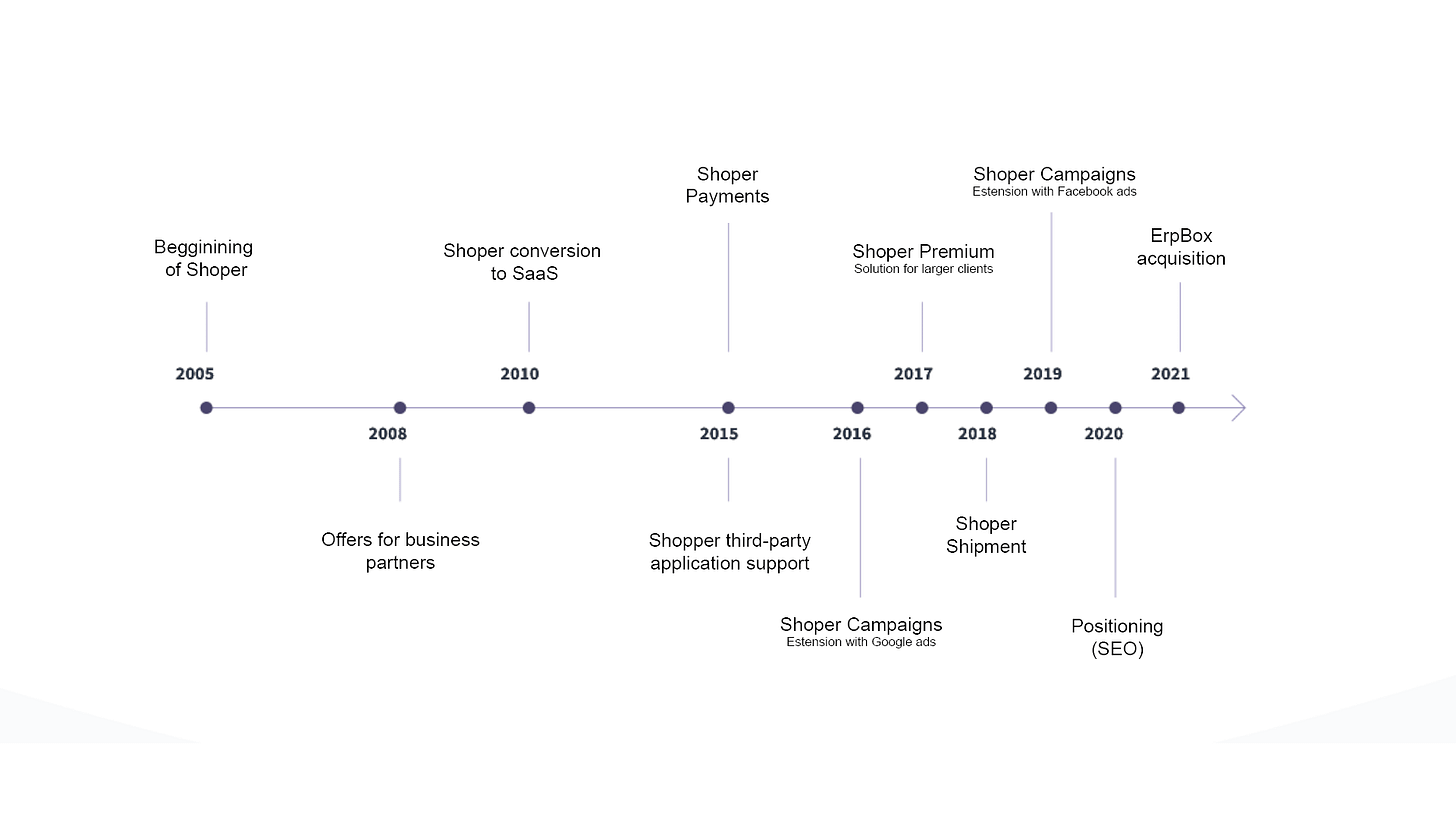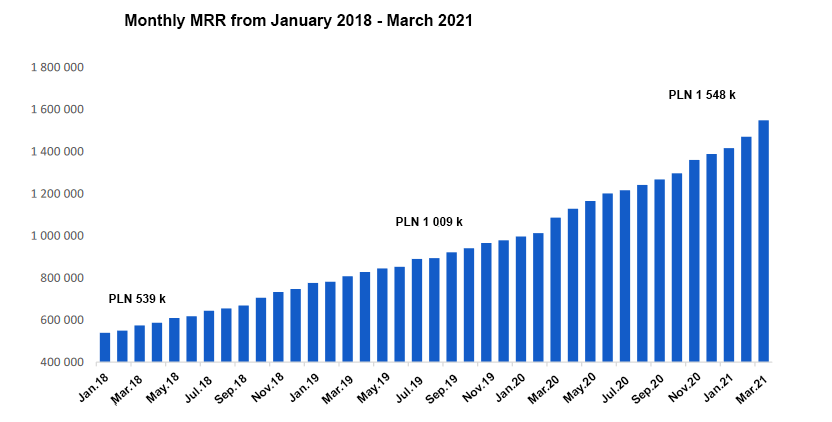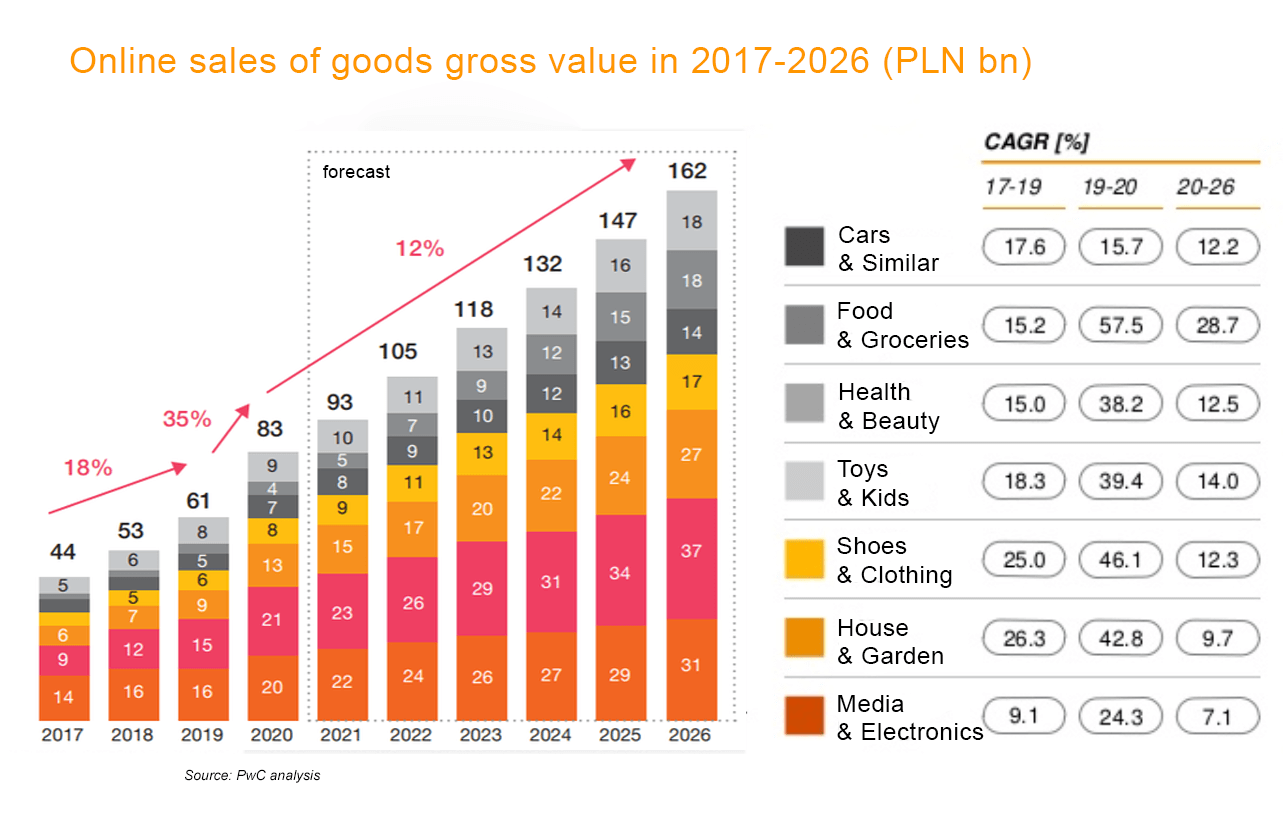Shoper IPO seems to be a great opportunity for long-term public investors to build exposure on rapidly growing eCommerce market in Poland 🇵🇱 and CEE region. Shoper with its thousands of merchants and their enlarging GMV (gross merchandise value) represents a shift in consumer behaviour towards digital distribution channels. Poland (as well as other CEE countries) with its relatively low online commerce penetration still has a way to grow businesses in that category. Jeff Bezos would probably say “It is still Day One”, but as a public investor you have to ask two critical questions:
Is Shoper worth more than PLN 1.4B (its implied IPO valuation) now?
How big it might become in my investment horizon?
Key Stats
>20k merchants on Shoper platform (including ~3k of partners)
Total revenue for the FY2020 grew to PLN 47m (+69% yoy); revenue for the last 12-months (LTM) grew to PLN 53.5m.
Gross merchandise value (GMV) for the FY2020 grew to PLN 4.0 billion (+87% yoy); GMV LTM grew to PLN 4.5 billion.
Adj. Cash-EBITDA grew to PLN 21.8m in FY2020 (+104%); and Adj. Cash-EBITDA LTM is almost PLN 25m.
Net profit for the FY2020 reached PLN 12.5m (+220%)
IPO value of PLN 363m (assuming max. IPO price of 47 PLN/share), as shareholders are selling up to 27.5% of total existing shares.
Implied valuation of PLN 1.4 billion. (it means…P/E at 113x)
History
Shoper has started out of creative frustration of its founders - Rafał and Krzysztof Krawczyk. In 2005 running a company that offered IT equipment (Devarea S.C.) they decided to set up an online store. At that time there were no ready-made solutions on the market, so they decided to outsource this work to individual programers, than write a code themselves. After three months of work a new software was ready and in mid-2005 the shop was launched. The software was so satisfactory that they decided to sell it to other companies and allow other users to create easy customisable online storefront using their tool. They named the solution Shoper®.
In 2010 Shoper converted its solution into a SaaS (software-as-a-service) model - clients no longer had to worry about issues like servers capacity, security or other issues typical to on-premise solutions. That’s when a real growth phase started.
Today the company and its founders are preparing for their big day - the IPO day.
Company overview
Product
Shoper enables small and medium businesses to bring their online store in easy, affordable way, basically limiting the cost of failure in online commerce close to zero. The company allows merchants to easily set up the front-end of the store (layout, logo, etc.) ant the back-end (online marketing campaigns, payment processing, applications, logistics services).
There are two main revenue sources:
1) Subscription solution revenue - primarily generated through the sale of its subscription to the platform. Shoper basically offers two types of subscriptions:
Shoper Standard - basic solution, dedicated for SMBs that start its online commerce or expand its offering through digital channels. Shoper Standard revenue is based on a fixed subscription.
Shoper Premium - advanced offer for more sophisticated merchants with higher GMV. Premium offers high level of personalisation, advanced features and dedicated customer support. Pricing on Shoper Premium is based on fixed subscription plus variable component (related to GMV of particular merchant).
In the last 2 years numbers of merchants subscribed to Shoper Premium grew significantly faster (CAGR +92%) than those with Standard subscription (CAGR +18%), accelerating Shoper’s revenue growth as their customers grow.
In 2020, even though there were just 6.5% Premium merchants in total number of Shoper subscription, they were responsible for ~40% of GMV, which grew rapidly at almost 80% CAGR in the last 2 years.👇
2) Additional services (Merchant solutions revenue)
Each merchant may use additional services not offered within basic subscription plan. For Shoper those are variable revenue streams (Pay-As-You-Grow model). Key additional services includes:
Shoper Campaigns - service allows users to operate online marketing campaigns on Facebook, Google, Allegro or Instagram.
Shoper Payments - Shoper’s own dedicated payment solution, with relatively low fees; suitable for every size of stores.
Shoper Applications - marketplace with third-party solutions; in 2020 there were 158 applications and integrations offered.
Shoper Shipments - integrates shipment methods with merchant shops; cover integrations with key logistics players and offer affordable fees.
Others - among others ErpBox (omnichannel solution), SSL, custom graphic design, accounting solutions. The list of applications and integrations is growing.
Those additional services and integrations add value for merchants by making them easily available within single platform.
Overall, revenue streams from pay-as-you-grow model (PAYG) have already been responsible for at least 50% of total revenue in 2020. Management’s goal for 2026 is to make 80% of total revenue from PAYG model.
Business Model
Shoper has been providing (since 2010) its services to customers in a SaaS (Software-as-a-Service) Model. Advantages of SaaS business model lie in its scalability and recurring character of revenues.
What is SaaS?
Software as a service (or SaaS) is a way of delivering applications over the Internet—as a service. Instead of installing and maintaining software, you simply access it via the Internet, freeing yourself from complex software and hardware management. (…)SaaS applications run on a SaaS provider’s servers. The provider manages access to the application, including security, availability, and performance.
source: salesforce.com/in/saas/
Company builds direct relationships with its merchants:
~80% of merchants comes to Shoper via its website or other direct channels;
97% of revenue for the last-12-months comes from direct relations with merchants.
Shoper’s MRR (Monthly Recurring Revenue) grew almost 3x from the beginning of 2018. Company takes into account in MRR calculation only revenue from subscription based services. MRR trend looks stellar strong.👇
Low churn and cohorts expansion
The company has provided limited information related to Churn Ratio or Net Revenue Retention that might be useful in assessing LTV (life-time value) of its customers or the relation between LTV and CAC (Customer Acquisition Costs), it stated than:
(…)99% of customers who churned their subscription for Company’s services have done so due to the discontinuation of services as an online store.
(…)the percentage of such cases is highest in the first year of operations as an online store, while after the second year it begins to decline.
(…)switching to open source model is also relatively rare, mainly due to costs and technical difficulties, as well as the limited benefits of such a change.
- source: Shoper’s prospectus
Based on our own calculations: Gross churn on Shoper platform was in range between 2.2 - 3.5% merchants (logo churn) per month in the last 2 years on average, and that number is decreasing.
ARPU (Average Revenue Per User) grew from avg. PLN 1.6k per customer in 2018 to over PLN 3.0k per customer for the last-12-months.
As ARPU grows at faster rate then merchants churns Shoper platform, it seems that since year 2020 company enjoys Net Revenue Retention over 100% (=negative net churn).
Likely its NRR (Net Revenue Retention) is much lower for tiny 1-2 persons shops that do go under from time to time, but on the other hand likely it’s much much higher (my guess: 130-140%+) for Shoper Premium and bigger merchants where lies significant value of the whole Shoper as a business.
Overall, cohorts of customers revenue expanded over time📈
Customers
Historically company targeted small and medium businesses (SMBs) that started with their online commerce activity. Shoper’s customer base is well-diversified, in 2020 Top 10 merchants accounted only for 4% of Total Revenue. Merchants from most of the sectors are represented on the platform (by % share)👇:
The long-term value of Shoper as a platform might depend on Management ability to serve growing cohorts of bigger, more demanding merchants that are already on the platform. Shoper challenge is to retain them within the platform as they scale operations. Shoper’s Managment plans to work on further product development, acquisitions or strategic partnerships with providers of solutions that might allow merchants to run online stores at scale. Recent acquisition of ErpBox seems to be a move in that direction.
(…) Now, we are going a step further... I am pleased to announce that Shoper has invested in the ErpBox omnichannel platform. This means dozens of new integrations with online store platforms (SaaS and Open Source), marketplaces, logistics solutions, ERP and CRM software and great support for dropshipping. Also, it is the possibility to sell abroad through Amazon, eBay, Kaufland and others. ErpBox will soon be multilingual and available for most popular online store platforms in CEE. Find out more at www.erpbox.pl
- public statement on LinkedIn from Marcin Kusmierz (CEO of Shoper), dated: 21/06/2021
Market opportunity
Covid-19 as a main catalyst accelerated a shift in consumer behaviour towards digital distribution channels, GMV for 🇵🇱 polish eCommerce in 2020 grew 35% to PLN 83B.
Still, in 2020 online sales accounted only for 14% of retail sales (= relatively low eCommerce penetration).
GMV for polish 🇵🇱 eCommerce is expected to reach PLN 162B by 2026 (+95% vs. 2020’ GMV; growing at 12% CAGR) and 20% of online penetration in retail market.
At the end of 2020 there were ~35k merchants that have built its online stores on SaaS platforms (+53% vs. year end 2017), 45% of them used Shoper platform👇
Shoper ecosystem grew significantly faster: GMV Shoper +87% vs. GMV Allegro +56% vs. GMV Poland +36% (2020 vs. 2019 yoy dynamics).
Interestingly, Shoper ecosystem (PLN ~4.5B GMV) already accounts for 1/7 of Allegro ecosystem (PLN ~35B GMV) and more than 5% of entire eCommerce in Poland.
Management
Management team seems to be very competent for the job, well motivated and aligned with shareholders interest.
Key personnel includes:
Marcin Kusmierz, CEO - one of the most experienced manager in online commerce, former CEO of Home.pl, in 2015 awarded as “CEO of the Year” by Polish Private Equity and Venture Capital Association. At Shoper responsible for implementation of the strategy and operations.
Krzysztof Krawczyk, Vice-President of the Management Board - co-founder, 15-years of experience, responsible for product development and key tech projects.
Paweł Rybak, Board Member - 17-years of experience in online marketing and eCommerce; former CEO of Sunrise System; responsible for marketing services.
Management team is going to still hold ~35% of shares after IPO process.
Investors
In May’2019 Value4Capital (V4C), private equity fund focused on the lower mid-market Polish and Central European buy-outs, announced the acquisition of a minority stake in the owner of Shoper. The value of V4C’s transaction was undisclosed, but it seems PE fund is going to realize a great return on that investment. How great?
As there was a comparable transaction (in October’2018 MCI Capital bought 51% in IAI - owner of Ido Sell, one of the biggest competitor to Shoper) just few months before V4C’s deal in Shoper, we tried to estimate the entry valuation of the PE fund assuming multiples for those businesses should be similar.
Based on that comparable deal, we can assume that V4C fund at the moment of IPO could be virtually making ~5 to 9x on its initial investment. Nice one! Currently, PE fund holds 34.8% of company shares (which it intends to reduced to 25.2% through the sale in the IPO process).
Financials
Total revenue for the FY2020 grew to PLN 47m (+69% yoy); revenue for the last 12-months (LTM) grew to PLN 53.5m.
Revenue 5Y CAGR (for the last 5 years) ~43% .
%EBITDA margin reached 42% in 2020 (vs. 29% in 2019).
There is a nice operating leverage (potential to increase %EBITDA towards 50-55% at scale) as indirect costs will likely grow at slower pace than Revenue or Gross Margin.
Company enjoys strong cash conversion: almost 100% of EBITDA is converted into Operating Cash Flows; each year of the last 3-year confirmed that relationship.
Basically, there is negative working capital (while scaling operations additional capital is not required).
Strategy and plans
There are four strategic areas to be developed by 2026:
Maintaining market leader position and expanding customer base to 50k merchants by 2026 (vs. 17k at the end of Q1’2021).
Further development of the Platform - management aims to ensure the functionalities of the platform are upgraded and improved; new services to be added in 2022, among others: Shoper Cloud / Customer Service (chatbot/chat) / Finance (financing products) / ID (one login to each merchant on Shoper platform) / Marketing.
Increasing revenues from pay-as-you-grow model (related to GMV of merchants) up 80% of total revenue.
Potential acquisitions - potential international expansion (EU countries or emerging markets) through M&A activity or acquisition of technology or competences.
Risks
Competition
Shoper’s strategy looks strong and company is definitely getting momentum, however there are some very high-quality companies that might be strong challangers in the long-term (for example Shopify, Wix, IdoSell). As platforms are integrating new services, their SaaS business is getting more complex. Will Shoper be able to stay ahead in the long-term?
Limited capacity of local market
So far, Shoper focused on Polish eCommerce market only. There is a risk that local market is too small to create a truly big player (and distinctive return potential for investors), especially given there are other companies looking to get a slice of the market pie.
High reliance on Small-Medium Businesses (SMB)
Smaller companies are usually more vulnerable. It’s not sure that small, independent eCommerce operators will find a winning formula for the market. There is a risk that significantly less independent online stores will be created in the future. Potentially, we might also see some consolidation in the market as eCommerce ecosystem is highly fragmented. Thus, there is a risk 50k stores target by 2026 (Management’s target) might not be reached.
Valuation
To estimate Enterprise Value (EV) investing in IPO you should take into account: 1) IPO price and existing shares 2) debt to existing shareholders (PLN 32.6m debt related to Series D Shares with will be redeemed once debt repaid); 3) approved ESOP plan for more than 2m new shares to be issued (~7.1% of existing shares), which will likely dilute new shareholders buying at IPO.
At max. IPO price (PLN 47.0/share), including ESOP shares, technically Enterprise Value (EV) is going to be PLN 1.45 Billion (we’ll use that figure in 👇 multiple calculations).
EV/EBITDA multiple based on last year results is some 73x(!), or P/E multiple ~113x.
However, if you believe in Management’s Strategy (50k merchants by FY2026, near 80% of GMV based revenue, new products/services, and some smart add-on acquisition) it might work.
Key assumptions:
a) No. of merchants in 2026 - 50k.
b) Shoper’s GMV in 2026 would account for 13% of entire Polish eCommerce market (vs. current 5%) -> so basically a bet, that Shoper is a winning SaaS solution in the market.
c) 75%+ of revenue related to GMV of merchants.
Financial model (P&L and Multiples) based on those:👇
Shoper is an inspiring company, with many characteristics of a great scalable business and super high ROIC. Whether you believe in Shoper’s Management execution capabilities you have to ask yourself.
We wish you great investment returns!
Thanks for reading!
Robert Ditrych
Disclaimer:
Invested Newsletter is for informational purposes only and should not be relied upon as a basis for investment decisions. Clients of mine or myself may maintain positions in the securities discussed in this newsletter.

















